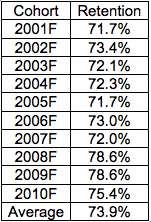Kent State retention rate decreased to 75.4 percent

September 22, 2011
University education is important to many employers today; however, one former Kent State student said with tuition and the cost of college being so high, it may not always be worth it.
Phil Bohannon, former integrated social studies major, dropped out of Kent State at the end of last semester for both economic and educational reasons.
“You don’t necessarily need a degree to get a job today,” Bohannon said. “Obviously, teachers, lawyers and doctors are recommended to stay in school, but it really depends on what you want to do.”
Kent State retention rates dropped from 78.6 percent to 75.4 percent this academic school year, which contrasts the university goal for an 80 percent retention rate.
“This percentage is lower than the average percentage rate over the last two years,” said Wayne Schneider,director for research planning and institutional effectiveness. “It’s also lower than some of the other universities in the state.”
Schneider said Miami, Ohio State and Ohio University all retain between 80 to 90 percent of their students. However, he said the 75.4 percent is still higher than Kent State’s historic average.
David Garcia, associate vice president for enrollment, said several other Ohio public universities such as Bowling Green State University and the University of Toledo reported a one to two percent decrease in student retention. He said retention may be a statewide problem because of these findings.
Schneider said the university researched different factors behind the retention rates, which take into account the college a student dropped out of, GPA levels and whether the students lived on campus or commuted.
“We look at all different kinds of things, and all the normal things we looked at are down compared to the last two years,” Schneider said. “But it is hard to measure certain other factors like motivation, economics and weather.”
Greg Jarvie, vice president of student enrollment, said he thinks students may be dropping as a result of the decreased number of student loan opportunities.
“With our economy, a lot more students are stepping out,” Jarvie said. “Money is tight, and more students are looking to step out for a semester or a year to make up tuition money and then return to school.”
Garcia said he believes some of the major reasons students may be dropping out or transferring to different universities is because of scholarship cuts, increased tuition and lack of grants.
“In my experience with higher education, many people believe there is one silver bullet that explains why students leave after their first year,” Garcia said. “But in study after study, we find there are many reasons why students leave college.”
Bohannon said both economics and grades influenced his decision to drop out.
“I mostly figured that I wasn’t going to get the grades I needed, and there was no use in going to school with all the loans I was going to have to pay back,” Bohannon said. “I had to stay above a certain GPA, and my parents said they weren’t going to pay for my college.”
Bohannon said he might consider returning to school in the future, but for the time being, he wants to stay in the workforce.
Provost Robert Frank said he suspects the highest dropout rate occurs after a first-year student’s second semester.
“We know students who get into trouble at midterms have much higher probabilities of leaving the university,” Frank said. “The irony is that students may not realize how deep the problem is until they really get into it.”
Frank said Kent State is using programs such as Early Alert or the new Math Emporium to help with these persistence problems.
“We’re hoping to refine our programs to work with students and give them more help before they get into too much trouble,” Frank said.
Eboni Pringle, executive director for student learning and success services, said retention will never be 100 percent at Kent State, but she believes conversing more with struggling students could increase retention numbers.
“With students who drop out, there is something that happens during their first year that causes them to decide not to continue,” Pringle said. “We’re really trying to use different lenses to view those students and identify how we can assist students who have difficulties or are considering leaving Kent State.”
Contact Megan Wilkinson at [email protected].
























